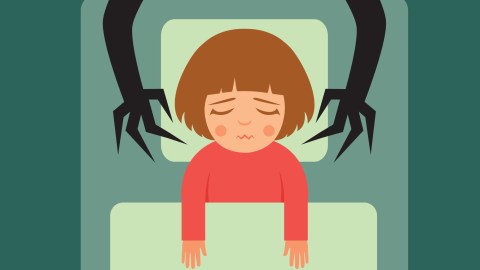What fear does to your brain — and how to stop it

From our televisions to our political conversations, we are inundated with messages of fear. We feel more afraid of the world and our own neighbors now than we have in decades. But all that fear isn’t good for us. In fact, according to neuroscience, fear is killing us.
First of all, fear is “a chain reaction in the brain,” according to How Stuff Works. Fear begins with a frightening stimulus and ends with your body preparing to protect itself from danger. It works like this: something frightens you, like seeing a cockroach, hearing a door slam in an empty apartment, or feeling a knife pressed into your throat. You feel dread, anxiety, and panic. Your heart races, your breathing quickens, and your muscles tense up. Your body goes into fight-or-flight mode, ready to do everything it needs to make you safe.
That entire reaction involves five different parts of your brain. It begins in the thalamus, which receives signals from your body’s senses. From there, there are two different paths the fear reaction can take: the low road or the high road. The low road is the quickest, basest, least-rational response to life-threatening situations. If one of those signals is life-threatening, like feeling a knife at your throat, the thalamus alerts your amygdala. Your amygdala triggers emotional responses and prompts your hypothalamus to turn up your adrenal glands and rush blood to your muscles to get you away from the danger.
If the signal isn’t life-threatening, the brain takes the more rational high-road response. If you see something that’s not life-threatening but still frightening, like a cockroach skittering across the floor, the amygdala alerts the pre-frontal or sensory cortex. The cortex alerts the hippocampus and spurs it to compare the current threat to past ones. The hippocampus is the brain’s memory center. If it determines that the current fear stimulus is a threat but not life-threatening, the hippocampus heightens your senses to an almost superhuman degree and triggers your fight-or-flight response. Both processes are automatic and happen within “fractions of a second” according to Edutopia.
As helpful as that response is, the speed and thoroughness of it can be detrimental. According to research out of the University of Minnesota, “once the fear pathways are ramped up, the brain short-circuits more rational processing paths and reacts immediately to signals from the amygdala. When in this overactive state, the brain perceives events as negative and remembers them that way.”
That’s unfortunate, because the brain stores all the details from that particular stimulus — time of day, images, sounds, smells, weather, etc — in your long-term memory. While that makes the memory “very durable, [it] may also be fragmented,” triggering the full gamut of physical and emotional responses every single time a similar fear stimulus shows up. That’s what’s known as fear conditioning, as the researchers explain:
Later, the sights, sounds, and other contextual details of the event can become stimuli themselves and trigger fear. They may bring back the memory of the fearful event, or they may cause us to feel afraid without consciously knowing why. Because these cues were associated with previous danger, the brain may see them as a predictor of threat.
That situation is particularly detrimental to people suffering from post-traumatic stress disorder (PTSD). Dr. Bessel van der Kolk explains how here:
While fear can play tricks with your memory and your perception of reality, it also affects your body. Fear can weaken the creation of long-term memories and damage the hippocampus, short-circuiting the response paths and causing constant feelings of anxiety. Fear can also have long-term consequences on our health, including “fatigue, chronic depression, accelerated ageing and even premature death,” again according to the University of Minnesota. And that’s only the start of their bad news:
To someone in chronic fear, the world looks scary and their memories confirm that. Moreover, fear can interrupt processes in our brains that allow us to regulate emotions, read non-verbal cues and other information presented to us, reflect before acting, and act ethically. This impacts our thinking and decision-making in negative ways, leaving us susceptible to intense emotions and impulsive reactions.
So being inundated with messages of fear and constantly processing them prompts tons of negative consequences for your body and psyche. But you don’t have to accept them. You can beat fear; you just need to train yourself.
The process of overcoming a fear memory is known as fear extinction. Fear extinction involves creating a new response to the fear-causing stimulus, meaning making positive associations with the thing that freaked you out. For example, if your fear response was triggered by seeing a cockroach skittering across the floor that response might trigger every time you see that chunk of the floor. That’s not terribly helpful, but if you looked at that same chunk of floor every single day without seeing cockroaches on it, the fear response would be rewritten. This works because “the amygdala wants to associate the memory with the freezing response, but it can be trained to associate it with something less debilitating,” explains Discover Magazine. Once the amygdala does that, the fear memory is rewritten.
Once that happens, you’re free of fear. Moral of the story: control your response to fear, don’t let fear control you.





